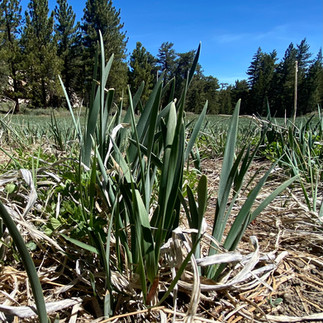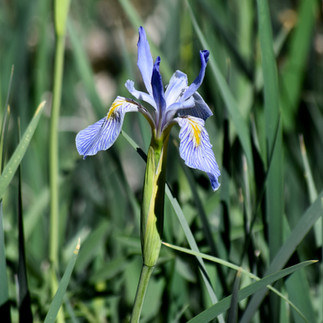Observations of a Wild Iris missouriensis Meadow
- Donnett Vanek

- Nov 28, 2022
- 8 min read

This year was the 25th Anniversary of the Botanical Artists Guild of Southern California. We had several events that celebrated the Iris, the flower that represents a 25th anniversary. BAGSC had a trip to an iris grower, a workshop on how to paint this beautiful and complicated flower, as well as a 25th Anniversary celebration and art exhibition of the Iridaceae family. The celebration and art exhibition were held at the Huntington Library, Art Museum, and Botanical Gardens in the Brody Botanical Center. Coinciding with this celebration of the iris, has been my observations of a wild Iris missouriensis meadow that grows near my home in the Los Padres National Forest. As 2022 draws to a close, I would like to share with you my year long observations of this beautiful meadow.

The beautiful California native Iris missouriensis meadow sits at an elevation of 8,360 ft at the Chula Vista Trailhead on Mt. Pinos. Iwihinmu'u, is the name of Mt. Pinos in the language of the Samala, who are Chumash Indians that occupied this land for generations. It is Liyikshup, the center of the world. The mountain summit has an elevation of 8,831ft.
I have been coming to this alpine wetland meadow for many years, it is an unexpected find so close to Los Angeles. This winter, I decided to visit the meadow to see what it was like after a recent snowstorm. Stepping out of the tall pines that surround the meadow, I noticed mounds of silvery dried long leaves of Iris missouriensis (Western Blue flag Iris) pushing through the snow. The mounds looked like small islands dotting the landscape of the snow covered meadow.

The dried leaves of the Western Blue Flag Iris twist and turn around tall graceful dried stems of the flowers. The mounds that the leaves form are thick and dense, looking somewhat like a an intricate woven nest. The stems curve gently over, most likely weighted down by the recent snowstorm. At the end of the stems are the beautiful dried seedpods of the iris flowers that dotted the landscape the previous summer. Stepping into this landscape of silvers and white is like stepping into a black and white photograph. As I was observing this landscape, I knew that I wanted to use these iris mounds as a subject for a graphite drawing. It was also the beginning of my idea to come back every few weeks to observe and chronicle the seasons of this wonderful wild meadow of Iris missouriensis.
I visited the meadow several more times after the winter storm. At first glance the meadow showed no signs of spring when I visited in late April. However, when I looked closely I saw small shoots of Iris missouriensis starting to push through the mounds of dried leaves. The first signs of spring had arrived to the meadow!

Since the iris had started to sprout I thought I might find other wildflowers near the meadow. However it was still a little too early in the season, and no other wildflowers were sprouting yet. There was one more sign of early spring in the meadow, and that was the Western Blue Birds. Their song could be heard throughout the meadow as they collected sticks for their nests. The blues of their feathers stood out in stark contrast to the browns and golds of the meadow.
I started returning weekly to the meadow. By now it was near the end of May, down in the basin of Los Angeles and the surrounding valleys, everything was in bloom. At the elevation of the meadow it takes a little longer for plants to come out of their dormancy. Finally, the meadow was showing signs of growth, and greenery was appearing throughout the underbrush of the mountain.

Standing on a knoll, overlooking the meadow I noticed some dry patches in the meadow. The meadow did not look as lush as it had in past years. I walked down to the meadow to look more closely and to see what plants were starting to fill in the meadow. The Iris missouriensis were getting taller, but buds had not started to show yet. Veratrum californicum, (Corn Lily) also grow in the meadow. The Corn Lily has large broad leaves and can grow up to 6ft in height with tall stalks of small greenish white flowers. Standing at the edge of the meadow it was apparent that the iris and lilies were not growing as thickly as in previous years. I could see more dirt and empty patches throughout the meadow.
There were a few other wildflowers starting to make an appearance around the Iris missouriensis meadow. Some of the wildflowers are quite small and can easily be overlooked when walking near the meadow. I did see some Erysimum capitatum (Douglas Wallflower), Viola pinetorum (Goosefoot yellow violet), Phacelia curvipes (Washoe Phacelia) and Colinsia torreyi (Torrey's Blue Eyed Mary's).
I kept visiting the Iris missouriensis on a weekly basis. It's easy to miss the bloom. The iris will suddenly burst out in bloom and just as quickly it will be over. This happened last year. I had been going up to the iris meadow and missed a week or two. When I finally made it back up to the meadow, all that was left were the spent iris flowers. This year I was determined not to miss the bloom!
I visited the meadow on June 14th, the meadow was in full bloom! It is a spectacular site to see. A field of beautiful Iris missouriensis (Western Blue Flag Iris).

The graceful flowers of the Western Blue Flag Iris stood on tall stems peeking out above their grass like leaves. They swayed gently in the mountain breeze. The flowers are a delicate lilac and white with deep purple veins and yellow at the center of the petals. Some are a deeper blueish lilac than others. The Iris missouriensis is a rhizomatous species of the genus Iris, in the family Iridaceae.
There are a few other smaller meadows of the Iris missouriensis throughout the Mt. Pinos area. Some are hard to find and easy to miss as you are walking along trails. This one is very assessable. It is just off the parking area of Mt. Pinos, near the Chula Vista campground. Most people who visit this spectacular meadow are careful not to tread on these delicate flowers. There are paths to follow all around the meadow, as well as a few spots that provide a panoramic view of the meadow. The meadow was buzzing with many pollinators. Large bumble bees would alight on a flower for a second or two then meander on to the next. Often there would be several pollinators on one flower, small bees, large bumble bees and other small insects.
I looked for other wildflowers that grew in the meadow or just on the edges of the meadow. I found Lupinus lepideus var.confertus (Clustered tidy lupine). These were clusters of small lupine growing through out the meadow. I have read that they can also grow somewhat taller than the ones that I observed in the meadow. Also growing in the meadow were the small dainty Allium denticulatum, (Toothed Onion or Wild onion). The lovely Delphinium gracilentum (Meadow Larkspur or Pine forest Larkspur) were growing close to the meadow near the pines and underbrush. This Larkspur is native and endemic to California.
There was one other wildflower that I was looking for, the beautiful Calochortus venstus (Butterfly Mariposa Lily). I was in luck, several patches of this wonderful lily were in bloom on a slope not too far from the meadow. They can range in color from a pale pink, almost white, to a deep magenta. Growing near the Butterfly Mariposa Lily were another type of lupine, which I think was the Lupinus elatus (Tall Silky Lupine). There are many types of lupine, and I am not an expert on wildflower identification. There were also patches of Monardella brewery subs. lanceolata (Mustang Mint) and Calystegia malacophylla subs. pedicellata (Sierra Morning Glory).
Although there were not as many wildflowers as in past years, it was still wonderful to be able to see this wetland wild iris meadow and the flowers and plants that grow near it.
I returned to the meadow as fall was starting to make its debut here in the mountains. By now the meadow had turned to yellows, golds and browns with touches of greens here and there.

Each season brings a unique view of the Iris missourinesis meadow. Although the iris have faded, they are still lovely in the fall. Tall slender stems with delicate dried seedpods peak through the long slender leaves that are starting to fade from green to brown.
Ribes cereus var. cereum (Wax Currant) and Symphoricarpos rotudifolius var. parishii (Snowberry), grew at the edge of the meadow as well as along trails throughout Mt.Pinos. The deep red berries of the Wax Currant and the white berries of the Snowberry are another sign that fall has arrived to the mountain. A few last lupine and Penstemon labrosus (Southern scarlet Penstemon) were in bloom along the trails near the meadow. Patches of Erigonum wrightii var. subscaposum (Wright's Buckwheat) grew along the trails, their small flowers starting to fade and turn to brown. Pollinators were still visiting this buckwheat and the few other remaining wildflowers. A slight chill was in the mountain breeze, a sure sign that winter was just around the corner. The seasons of the wild Iris missourensis meadow were ready to start all over again.
As I visited the wild Iris missouriensis meadow this year, my thoughts kept returning to the feeling that the meadow was showing signs of drought. According to the California Department of Water Resources, "The water year that ended September 30 was the second driest on record, due to extreme heat and lack of rain and snow. All 58 counties in California are now under a drought emergency proclamation." A water year runs from October 1 to September 30th. This is the official 12 month time frame used to compile water records.
I decided to go back and compare photos from 2019 just before this most recent drought. 2019 happened to be a year of super wildflower blooms throughout California. It was a year that had just the right amount of precipitation and sunshine.

This is a photo of the Iris issourinesis meadow in July of 2019. The meadow is a lush green with many blooms through out the meadow. There were no dry patches as I had seen this year at the meadow.

This is a photo of the meadow in July 2022. The photos are looking in the same direction. Here the blooms are spent and the meadow is already turning brown. Large areas of dirt can be seen whereas in the photo from 2019 the Iris are growing much thicker with undergrowth of other plants.

Blossoms of the Western Blue Flag Iris in 2019 are numerous across the meadow.

The blossoms of 2022 at the meadow were not as abundant as the blossoms of 2019.
As I compared the photos from the two years, I realized that the meadow in 2022 came into bloom a few weeks earlier than in 2019 and seemed to last a shorter amount of time. By July of 2022 the blossoms were spent, the meadow fading to brown, looking more like fall. In 2019, the meadow was in full bloom during July, green and lush. By comparing these photos I had taken over the last few years I was able to see how the drought is affecting one small region of California. A small example of what is happening throughout the state.
I will continue to visit this beautiful wetland Iris missourinesis meadow at Mt. Pinos. Observing the plants that grow in and around the meadow. Finding inspiration for my favorite subject matter, botanical art depicting California native plants and their pollinators.
For information on plant resources and information please follow the links below.
For California plant resources :
About drought in California:
The Botanical Artists Guild of Southern California will hold its final and fun all-member quarterly meeting of 2022 onsaturday, December 10,2022. The meeting will be at 9:30am Pacific Time via Zoom. The meeting will be recorded. If you are a BAGSC member RSVP at: https://www.bagsc.org/dec-quarterly-meeting-martin You will have to log into the BAGSC site to be able to access the information for the quarterly meeting.
After a short meeting, our speaker will be Martin J. Allen, who will join us from the UK.
Martin’s talk will cover the use of colour and a minimal palette, how he plans paintings, and his research into England’s Ancient Grasslands. There will be the opportunity to ask questions, but only easy ones that he can answer.
We will close out our meeting with our 25th Anniversary presentation.
Are you a member of the American Society of Botanical Artists and the Botanical Artists Guild of Southern California, or would like to become a member? To renew membership or to join please follow this link:




















































































































Comments